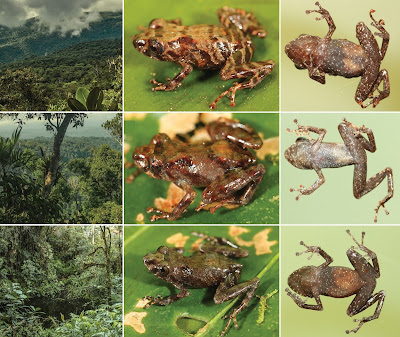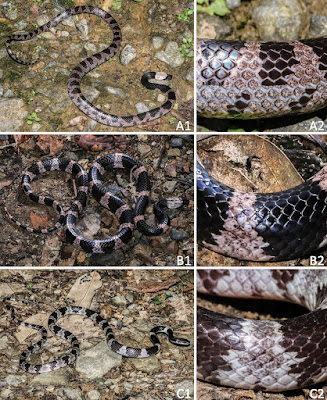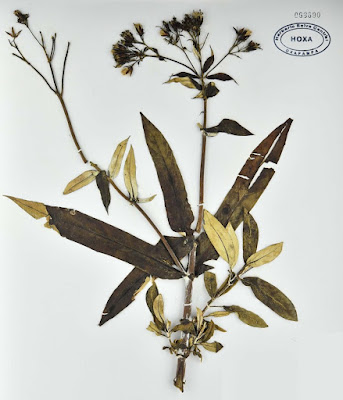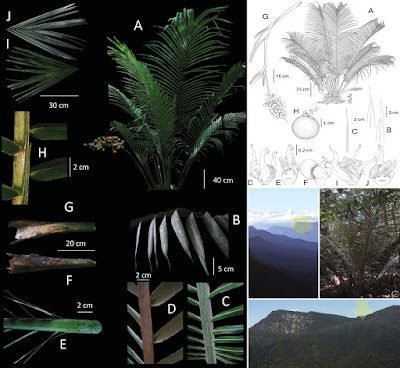[Most Recent Entries] [Calendar View]
Tuesday, April 13th, 2021
| Time | Event | ||||
| 5:58a | [Herpetology • 2021] Pristimantis sira • Beauty is in the Eye of the Beholder: Cruciform Eye reveals New Species of Direct-developing Frog (Strabomantidae, Pristimantis) in the Amazonian Andes
Abstract We describe a new species of frog from the eastern slopes of the Andes in central Peru. Pristimantis sira sp. nov. has a distinctive crossing mark on the iris and no tympanum. The new species is closely related to P. antisuyu Catenazzi & Lehr, 2018, P. cruciocularis Lehr, Lundberg, Aguilar & von May, 2006, and P. erythroinguinis Catenazzi & Lehr, 2018, but is easily differentiable by lacking colour blotches on groins. Pristimantis sira sp. nov. inhabits the mountain forests from 1550 to 2200 m a.s.l., inside a national reserve threatened by illegal mining. Key Words: Andes, crossing mark, iris, national reserve, illegal mining Pristimantis sira sp. nov. Diagnosis: The new species is diagnosed by the following combination of characters: (1) skin on dorsum finely shagreen with a few scattered subconical tubercles, that on venter areolate, W-shaped scapular fold present, discoidal fold absent, dorsolateral folds absent; (2) tympanic membrane and tympanic annulus absent, supratympanic fold absent; (3) snout acutely rounded from dorsal view, moderate in length and rounded from lateral view, canthus rostralis weakly concave in dorsal view, angular in lateral view, loreal region concave, rostral papilla or keel absent; (4) upper eyelid bearing two or three sub conical small tubercles, narrower than IOD, cranial crests absent; (5) dentigerous process of vomers absent; (6) males with vocal sacs and vocal slits, nuptial excrescences absent; (7) heels lacking tubercles; (8) finger I shorter than finger II, tips of digits expanded, bearing circumferential grooves, discs about 1.5 times wider than digits in fingers I, II and III, finger IV bearing a rounded disc about twice as wide as its digit; (9) fingers with narrow lateral fringes; (10) antebrachial tubercle absent; (11) ulnar and tarsal tubercles absent (12) inner metatarsal tubercle oval twice as long as round outer metatarsal tubercle, low supernumerary plantar tubercles at the base of toes II, III, IV and V; (13) toes without lateral fringes, webbing absent, toe V longer than toe III; (14) in life, dorsum yellowish-brown, dark brown or olive brown with dark transversal bands; interorbital bar dark brown; canthus rostralis paler than loreal region and dark bordered; dark labial bars present; throat, chest, and belly dark brown or dark grey with scattered white flecks; groins, posterior surfaces of thighs, and shanks dark brown; iris copper yellow with a vertical black line and dark reticulations, black pupil surrounded by a copper orange ring; (15) SVL 12.9–14.7 mm in males; 19.0–20.4 mm in females. Etymology: The species epithet “sira” is a noun in apposition, referencing El Sira Communal Reserve, a protected area established in 2001, containing the type locality of the new species. El Sira also protects one of the last large extensions of primary mountain forests in Central Peru. Germán Chávez, Luis A. García-Ayachi and Alessandro Catenazzi. 2021. Beauty is in the Eye of the Beholder: Cruciform Eye reveals New Species of Direct-developing Frog (Strabomantidae, Pristimantis) in the Amazonian Andes. Evolutionary Systematics. 5(1): 81-92. DOI: 10.3897/evolsyst.5.63674 | ||||
| 6:01a | [Herpetology • 2020] Lycodon cathaya • A New Species of the Genus Lycodon (Serpentes, Colubridae) from Guangxi, China
Abstract A new species of colubrid snake, Lycodon cathaya sp. nov., is described based on two adult male specimens collected from Huaping Nature Reserve, Guangxi, southern China. In a phylogenetic analyses, the new species is shown to be a sister taxon to the clade composed of L. futsingensis and L. namdongensis with low statistical support, and can be distinguished from all known congeners by the significant genetic divergence in the mitochondrial cytochrome b gene fragment (p-distance ≥ 7.9%), and morphologically by the following combination of characters: (1) dorsal scales in 17–17–15 rows, smooth throughout; (2) supralabials eight, third to fifth in contact with eye, infralabials nine; (3) ventral scales 199–200 (plus two preventral scales), subcaudals 78; (4) loreal single, elongated, in contact with eye or not, not in contact with internasals; (5) a single preocular not in contact with frontal, supraocular in contact with prefrontal, two postoculars; (6) maxillary teeth 10 (4+2+2+2); (7) two anterior temporals, three posterior temporals; (8) precloacal plate entire; (9) ground color from head to tail brownish black, with 31–35 dusty rose bands on body trunk, 13–16 on tail; (10) bands in 1–2 vertebral scales broad in minimum width; (11) bands separate ground color into brownish black ellipse patches arranged in a row along the top of body and tail; (12) elliptical patches in 3–6 scales of the vertebral row in maximum width; (13) ventral surface of body with wide brownish black strip, margined with a pair of continuous narrow greyish white ventrolateral lines. With the description of the new species, 64 congeners are currently known in the genus Lycodon, with 16 species occurring in China. Keywords: Colubrinae, Guangxi, Lycodon cathaya sp. nov., morphology, phylogeny, taxonomy 
Lycodon cathaya sp. nov. Diagnosis: Lycodon cathaya sp. nov. can be differentiated from its congeners by the combination of the following morphological characters: (1) dorsal scales in 17–17–15 rows, smooth throughout; (2) supralabials eight, third to fifth in contact with eye, infralabials 9; (3) ventral scales 199–200 (plus two preventral scales), subcaudals 78; (4) loreal single, elongated, in contact with eye or not, not in contact with internasals; (5) a single preocular not in contact with frontal, supraocular in contact with prefrontal, two postoculars; (6) maxillary teeth 10 (4+2+2+2); (7) two anterior temporals, three posterior temporals; (8) precloacal plate entire; (9) ground color from head to tail brownish black, with 31–35 dusty rose bands on body trunk, 13–16 on tail; (10) bands in 1–2 vertebral scales broad in minimum width; (11) bands separate ground color into brownish black ellipse patches, similar arrangement in a row along the top of body and tail; (12) elliptical patches in 3–6 scales of the vertebral row in maximum width; (13) ventral surface of body with a wide brownish black strip, margined with a pair of continuous narrow greyish white ventrolateral lines. Etymology: The specific name cathaya is a noun referring to the monotypic botanic genus Cathaya Chun & Kuang, 1958. The single species Cathaya argyrophylla Chun & Kuang, 1958 is an endangered relict plant, and was firstly discovered from Huaping Nature Reserve by the investigation team of Sun Yat-sen University. In memory of the predecessors and their contributions on the taxonomy of Chinese flora and fauna, we denominate this new snake species from Huaping Nature Reserve as Lycodon cathaya sp. nov. Its common name is suggested as “Huaping Wolf Snake” in English and “Hua Ping Bai Huan She (花坪白环蛇)” in Chinese. Jian Wang, Shuo Qi, Zhi-Tong Lyu, Zhao-Chi Zeng and Ying-Yong Wang. 2020. A New Species of the Genus Lycodon (Serpentes, Colubridae) from Guangxi, China. ZooKeys. 954: 85-108. DOI: 10.3897/zookeys.954.53432 | ||||
| 9:08a | [Botany • 2020] Nordenstamia valenzuelae • A New Species of Nordenstamia (Compositae, Senecioneae) from central Peru Abstract Nordenstamia valenzuelae sp. nov. is described from the Pui Pui Protection Forest in central Peru. It is a shrub characterized by opposite leaves (upper ones sessile), adaxial leaf surfaces and young stem parts covered by short-stipitate, basic T-shaped, golden-yellow trichomes, and densely white lanate abaxial leaf surfaces. The new species is compared with the morphologically closest taxa and useful characters for their proper identification are provided. A dichotomous key including the Nordenstamia species with consistently opposite phyllotaxy is also presented. Keywords: Andes, Asteraceae, new species, taxonomy, Eudicots Hamilton Beltrán and Joel Calvo. 2020. A New Species of Nordenstamia (Compositae, Senecioneae) from central Peru. Phytotaxa. 474(3); 293–297. DOI: 10.11646/phytotaxa.474.3.8 | ||||
| 9:36a | [Botany • 2021] Ceroxylon ravenii • A New Species of Ceroxylon (Arecaceae) from Cordillera Azul National Park, Peru
Abstract A new species of Ceroxylon from the Cordillera Azul National Park in Peru is described and illustrated. The main distinguishing feature of the new species, named C. ravenii, is its acaulescent habit. So far, only one population has been recorded at an elevation of 1240 m in the wilderness zone of the protected area. Keywords: Arecaceae, Ceroxylon, Cordillera Azul National Park, new species, Monocots Ceroxylon ravenii Etymology:—This species is named in honor of Dr. Peter H. Raven, director of the Missouri Botanical Garden from 1971 to 2011, who is one of the main promoters of botanical research in Peru and the world to preserve endangered plants, also considered a great defender of conservation and sustainable environment. María Isabel Villalba Valdivia and Luis Valenzuela Gamarra. 2021. A New Species of Ceroxylon (Arecaceae) from Cordillera Azul National Park – Peru. Phytotaxa. 483(3); 267–276. DOI: 10.11646/phytotaxa.483.3.6 |
| << Previous Day |
2021/04/13 [Calendar] |
Next Day >> |

























